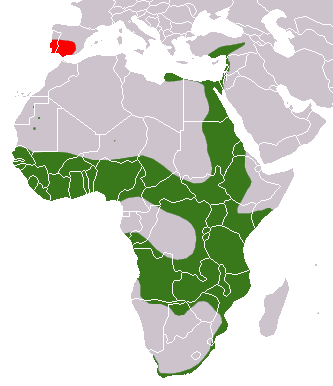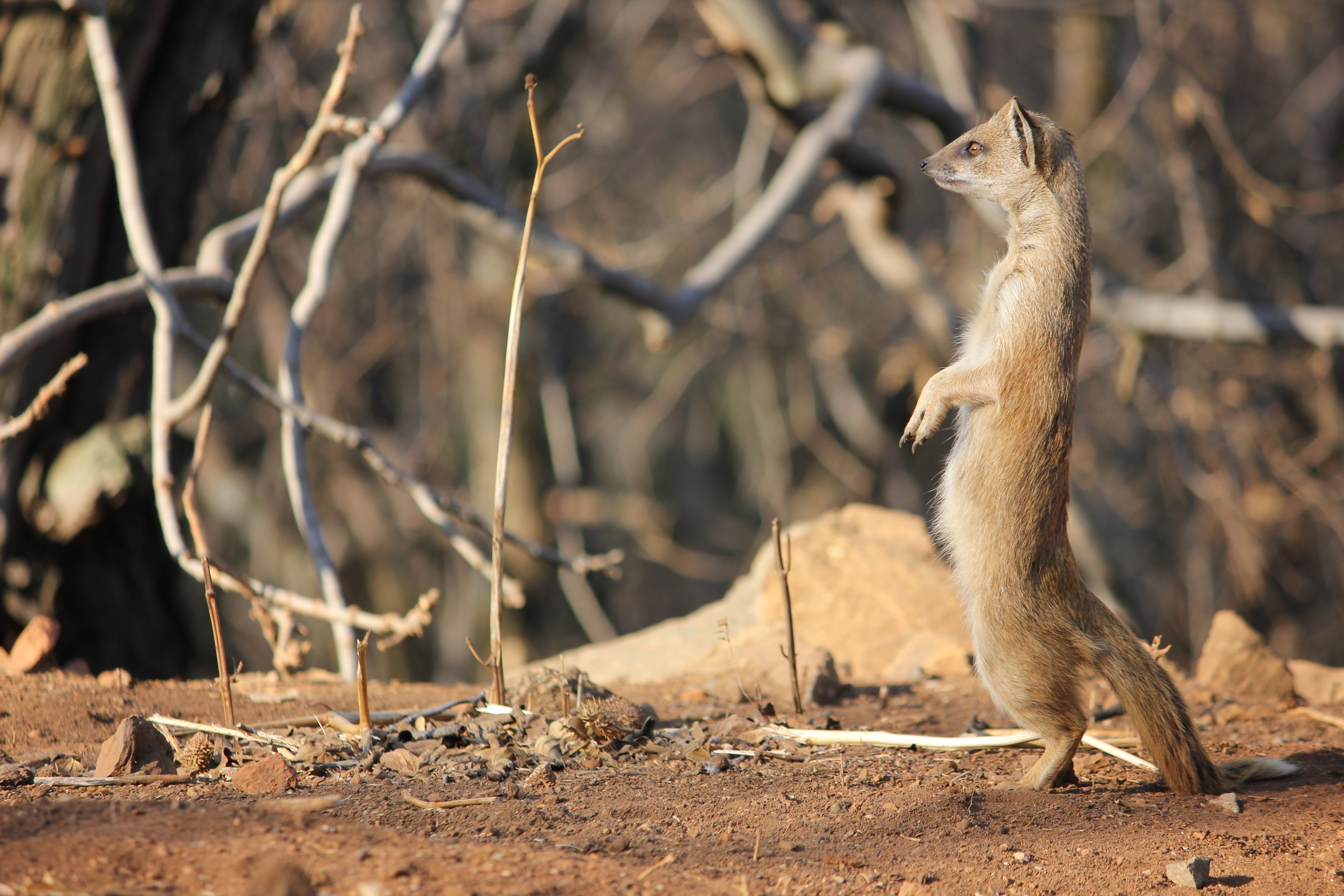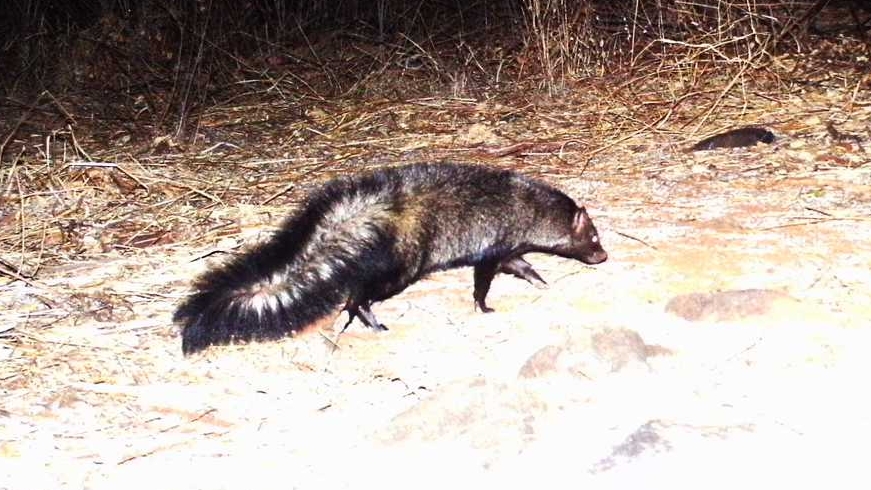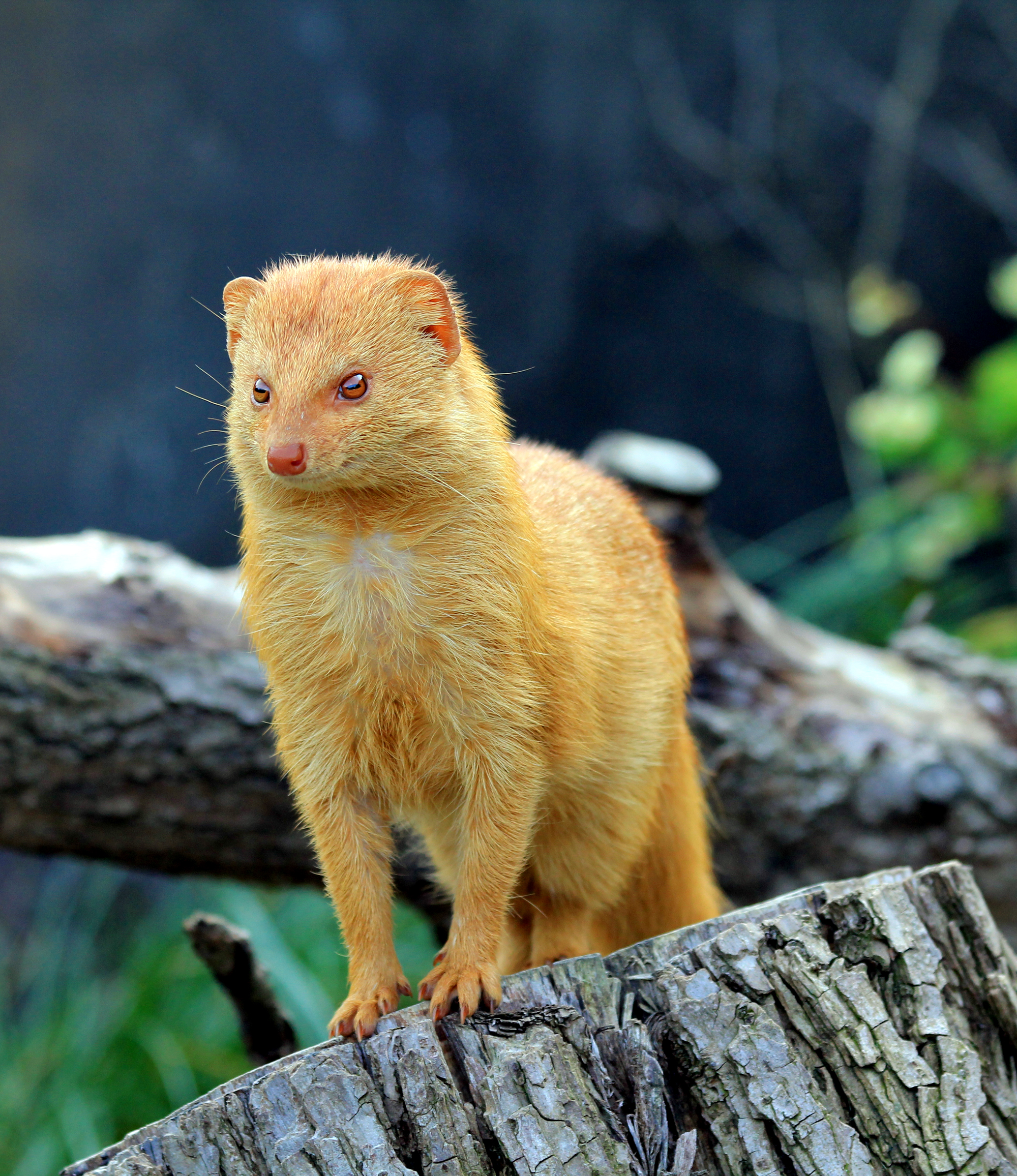|
Mongoose
A mongoose is a small terrestrial carnivorous mammal belonging to the family Herpestidae. This family is currently split into two subfamilies, the Herpestinae and the Mungotinae. The Herpestinae comprises 23 living species that are native to southern Europe, Africa and Asia, whereas the Mungotinae comprises 11 species native to Africa. The Herpestidae originated about in the Early Miocene The Early Miocene (also known as Lower Miocene) is a sub-epoch of the Miocene epoch (geology), Epoch made up of two faunal stage, stages: the Aquitanian age, Aquitanian and Burdigalian stages. The sub-epoch lasted from 23.03 ± 0.05 annum, Ma to ... and Genetic divergence, genetically diverged into two main genetic lineages between 19.1 and . Etymology The English word "mongoose" used to be spelled "mungoose" in the 18th and 19th centuries. The name is derived from names used in India for ''Herpestes'' species: or in classical Hindi; in Marathi language, Marathi; in Telugu language, T ... [...More Info...] [...Related Items...] OR: [Wikipedia] [Google] [Baidu] |
Indian Gray Mongoose
The Indian grey mongoose (''Urva edwardsii'') is a mongoose species native to the Indian subcontinent and West Asia. It is listed as Least Concern on the IUCN Red List. The grey mongoose inhabits open forests, scrublands and cultivated fields, often close to human habitation. It lives in burrows, hedgerows and thickets, among groves of trees, and takes shelter under rocks or bushes and even in drains. It is bold and inquisitive but wary, seldom venturing far from cover. It is an excellent climber and usually lives singly or in pairs. Its prey includes rodents, snakes, birds’ eggs and hatchlings, lizards and a variety of invertebrates. Along the Chambal River it occasionally feeds on gharial eggs. It breeds throughout the year. Characteristics The Indian grey mongoose has tawny grey or iron grey fur, which is more grizzled and stiffer and coarser than that of other mongooses. The ruddiness of the coat varies in different subspecies, but it is described as appearing more grey ... [...More Info...] [...Related Items...] OR: [Wikipedia] [Google] [Baidu] |
Herpestes
''Herpestes'' is a genus within the mongoose family Herpestidae. Several species in the family are known as slender mongooses. It is the type genus of the family, and comprises 5-6 living species, each with several subspecies. Fossil remains of three prehistoric species were excavated in France, and described in 1853. Characteristics The living ''Herpestes'' species are sexually dimorphic, with females smaller than males. They range in weight from . They share several characteristics, including the shape of the cheek teeth and of the tympanic bullae, and the presence of the first upper molar teeth. They are all solitary. Males have one chromosome less than females, as one Y chromosome is translocated to an autosome. Classification The scientific name ''Herpestes'' was proposed by Johann Karl Wilhelm Illiger in 1811 for mongoose species in the south of the Old World, commonly called "Ichneumon" at the time. Until 1835, 12 mongoose species from Africa and Asia were clas ... [...More Info...] [...Related Items...] OR: [Wikipedia] [Google] [Baidu] |
Galerella
''Herpestes'' is a genus within the mongoose family Herpestidae. Several species in the family are known as slender mongooses. It is the type genus of the family, and comprises 5-6 living species, each with several subspecies. Fossil remains of three prehistoric species were excavated in France, and described in 1853. Characteristics The living ''Herpestes'' species are sexually dimorphic, with females smaller than males. They range in weight from . They share several characteristics, including the shape of the cheek teeth and of the tympanic bullae, and the presence of the first upper molar teeth. They are all solitary. Males have one chromosome less than females, as one Y chromosome is translocated to an autosome. Classification The scientific name ''Herpestes'' was proposed by Johann Karl Wilhelm Illiger in 1811 for mongoose species in the south of the Old World, commonly called "Ichneumon" at the time. Until 1835, 12 mongoose species from Africa and Asia were classified as b ... [...More Info...] [...Related Items...] OR: [Wikipedia] [Google] [Baidu] |
Mungos
''Mungos'' is a mongoose genus that was proposed by Étienne Geoffroy Saint-Hilaire and Frédéric Cuvier in 1795. The genus contains the following species In biology, a species is the basic unit of classification and a taxonomic rank of an organism, as well as a unit of biodiversity. A species is often defined as the largest group of organisms in which any two individuals of the appropriat ...: References Mongooses Carnivorans of Africa Taxa named by Étienne Geoffroy Saint-Hilaire Taxa named by Frédéric Cuvier {{carnivora-stub ... [...More Info...] [...Related Items...] OR: [Wikipedia] [Google] [Baidu] |
Ichneumia
The white-tailed mongoose (''Ichneumia albicauda'') is a species in the mongoose family Herpestidae. It is the only member of the genus ''Ichneumia''. Taxonomy ''Herpestes albicaudus'' was the scientific name proposed by Georges Cuvier in 1829 for a mongoose specimen with a white tail from Senegal. The genus name ''Ichneumia'' was coined by Isidore Geoffroy Saint-Hilaire in 1837. Characteristics The white-tailed mongoose attains a weight range of , with an average of approximately , has a head-and-body length of and a tail length of .Egi, N. (2001). ''Body mass estimates in extinct mammals from limb bone dimensions: the case of North American hyaenodontids''. Palaeontology, 44(3), 497-528. On average it appears to be the longest and heaviest extant species of mongoose, although its linear and body mass parameters broadly overlap with other larger mongoose species, in particular, the marsh mongoose seems to most closely rival (and possibly match) in range of body masses repo ... [...More Info...] [...Related Items...] OR: [Wikipedia] [Google] [Baidu] |
Yellow Mongoose
The yellow mongoose (''Cynictis penicillata''), sometimes referred to as the red meerkat, is a member of the mongoose family. It averages about in weight and about in length. It lives in open country, semi-desert scrubland and grasslands in Angola, Botswana, South Africa, Namibia, and Zimbabwe. It is the only species in the genus ''Cynictis''. Taxonomy ''Herpestes penicillatus'' was the scientific name proposed by Georges Cuvier in 1829 for a mongoose specimen from the Cape. The generic name ''Cynictis'' was proposed by William Ogilby in 1833 for a specimen collected in Kaffraria. ''Cynictis penicillata'' is the only member of the genus, but as many as twelve subspecies of yellow mongoose have been described. Characteristics In general, the yellow mongoose has lighter highlights on the underbelly and chin, a bushy tail, and a complete lack of sexual dimorphism. Southern yellow mongooses are larger, have yellow or reddish fur, longer fur, and a longer tail with a characte ... [...More Info...] [...Related Items...] OR: [Wikipedia] [Google] [Baidu] |
Cynictis
The yellow mongoose (''Cynictis penicillata''), sometimes referred to as the red meerkat, is a member of the mongoose family. It averages about in weight and about in length. It lives in open country, semi-desert scrubland and grasslands in Angola, Botswana, South Africa, Namibia, and Zimbabwe. It is the only species in the genus ''Cynictis''. Taxonomy ''Herpestes penicillatus'' was the scientific name proposed by Georges Cuvier in 1829 for a mongoose specimen from the Cape. The generic name ''Cynictis'' was proposed by William Ogilby in 1833 for a specimen collected in Kaffraria. ''Cynictis penicillata'' is the only member of the genus, but as many as twelve subspecies of yellow mongoose have been described. Characteristics In general, the yellow mongoose has lighter highlights on the underbelly and chin, a bushy tail, and a complete lack of sexual dimorphism. Southern yellow mongooses are larger, have yellow or reddish fur, longer fur, and a longer tail with a characte ... [...More Info...] [...Related Items...] OR: [Wikipedia] [Google] [Baidu] |
Crossarchus
''Crossarchus'' is a mongoose genus, commonly referred to as kusimanse, often cusimanse, mangue, or dwarf mongoose. They are placed in the subfamily Mungotinae, which are small, highly social mongooses. Range and habitat Members of this genus are found in the swamplands and forests of central and western Africa, in the countries of Ghana, Ivory Coast, Liberia, and Sierra Leone. Species Diet They feed on insects, larvae, small reptiles, crabs and berries. They use their claws and snouts for digging in leaf litter, under rotted trees and stones for the insects and larvae. They will also wade into shallow streams looking for freshwater crab Around 1,300 species of freshwater crabs are distributed throughout the tropics and subtropics, divided among eight families. They show direct development and maternal care of a small number of offspring, in contrast to marine crabs, which releas ...s. In most areas where members of ''Crossarchus'' live, they are the numerically d ... [...More Info...] [...Related Items...] OR: [Wikipedia] [Google] [Baidu] |
Rhynchogale
Meller's mongoose (''Rhynchogale melleri'') is small brown mongoose native to savannas and woodlands of southeastern Africa. It is the only member of the genus ''Rhynchogale''. The Meller's mongoose lives alone and is active at night, feeding on termites or other small insects and animals. While somewhat rare, it is adaptable and faces no serious threats. It is a member of the mongoose family ( Herpestidae), a group of fox-like animals native to Asia, southern Europe, and Africa. Taxonomy The scientific name ''Rhinogale melleri'' was proposed by John Edward Gray in 1865 for a grey-brown mongoose zoological specimen collected in East Africa. It was placed in the genus ''Rhynchogale'' by Oldfield Thomas in 1894. Description Meller's mongoose is a medium to large-size mongoose with a light to dark brown body and a long tail. At close quarters the upper parts of Meller's mongoose are coarsely grizzled. The lower parts of the limbs are darker than the upper parts of the body. The ... [...More Info...] [...Related Items...] OR: [Wikipedia] [Google] [Baidu] |
Bdeogale
''Bdeogale'' is a mongoose genus that was proposed by Wilhelm Peters in 1850 based on a mongoose specimen collected in Mozambique. ''Bdeogale'' species have compact paws with four symmetrical toes, round ears and a blunt muzzle with a broad round and bare rhinarium. The genus contains four species that are primarily terrestrial and omnivorous An omnivore () is an animal that has the ability to eat and survive on both plant and animal matter. Obtaining energy and nutrients from plant and animal matter, omnivores digest carbohydrates, protein, fat, and fiber, and metabolize the nut ... and forage in dense vegetation. Species References External links Mongooses of Sub-Saharan Africa Taxa named by Wilhelm Peters {{carnivora-stub ... [...More Info...] [...Related Items...] OR: [Wikipedia] [Google] [Baidu] |
Helogale
''Helogale'' is a genus of the mongoose family (Herpestidae). It consists of two species and 12 subspecies: Extant Species The helogales are the smallest species of mongooses and both are endemic to Africa. The distribution of the Ethiopian dwarf mongoose is more tropical, and overlaps completely with that of the common dwarf mongoose, which is more widespread. Both are social diurnal species, and due to their small sizes they are vulnerable to predation. Both species live independently of open water. References * The Kingdon Field Guide to African Mammals, 1997, Jonathan Kingdon. * Anne Rasa Olwen Anne Elisabeth Rasa (1940 – 15 November 2020) was a British ethologist, known for her long-duration study of the social behaviour of the dwarf mongoose in Kenya. She had studied aggression among coral reef fish under the pioneering ethol ...: ''Mongoose Watch: A Family Observed'', 1985, John Murray. Mongooses Taxa named by John Edward Gray {{carnivora-s ... [...More Info...] [...Related Items...] OR: [Wikipedia] [Google] [Baidu] |
Slender Mongoose
The common slender mongoose (''Herpestes sanguineus''), also known as the black-tipped mongoose or the black-tailed mongoose, is a very common mongoose species native to sub-Saharan Africa. Taxonomy The scientific name ''Herpestes sanguineus'' was proposed by Eduard Rüppell in 1835 who described a reddish mongoose observed in the Kordofan region. Range and habitat The common slender mongoose, with up to fifty subspecies, are found throughout sub-Saharan Africa, with the black mongoose of Angola and Namibia sometimes considered a separate species. They are adaptable and can live nearly anywhere in this wide range, but are most common in the savannah and semiarid plains. They are much rarer in densely forested areas and deserts. Description As the name suggests, the common slender mongoose has a lithe body of and a long tail of . Males weigh , while the smaller females weigh . The color of their fur varies widely between subspecies, from a dark reddish-brown to an orange re ... [...More Info...] [...Related Items...] OR: [Wikipedia] [Google] [Baidu] |



.jpg)





